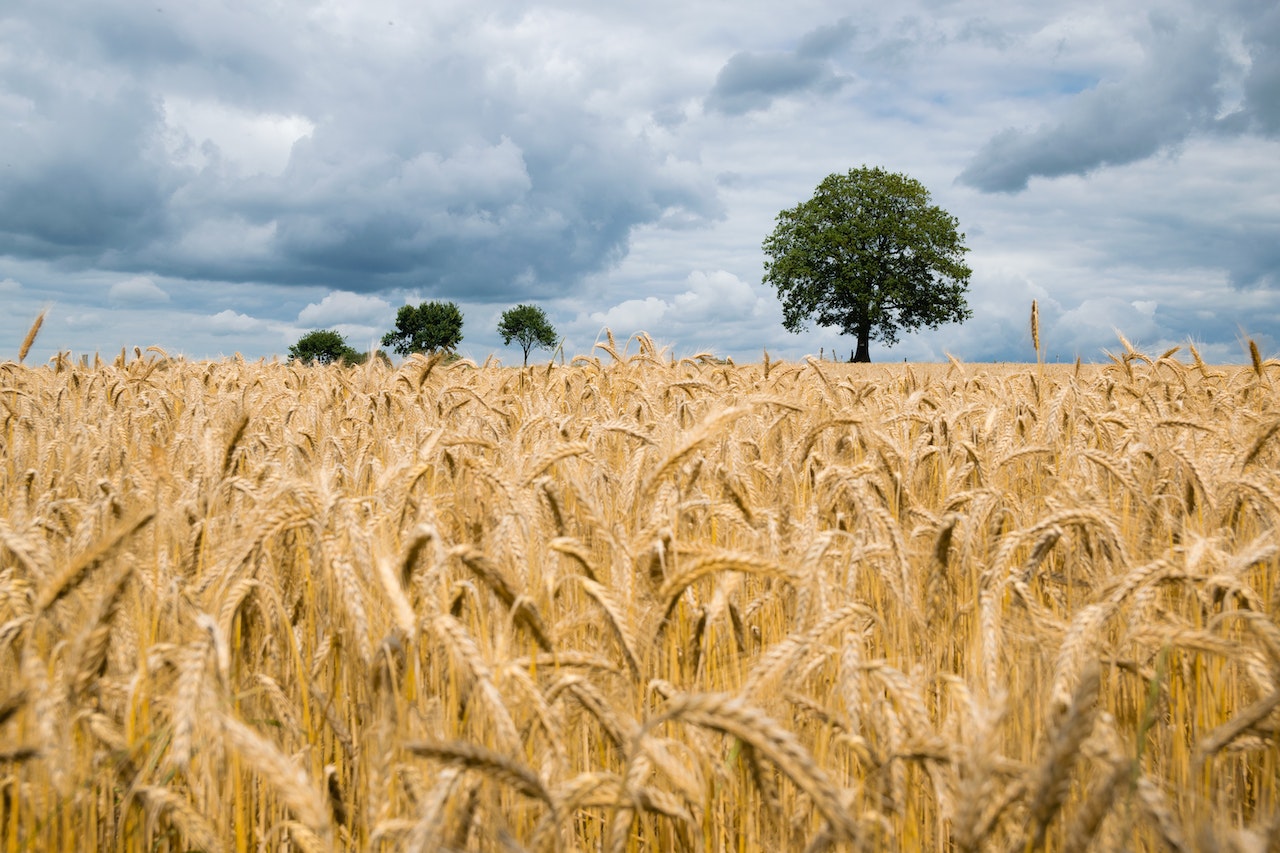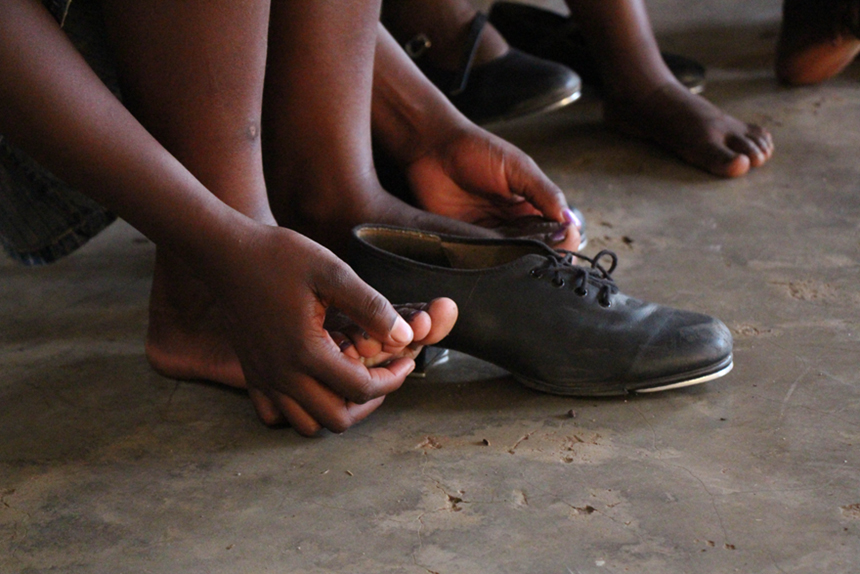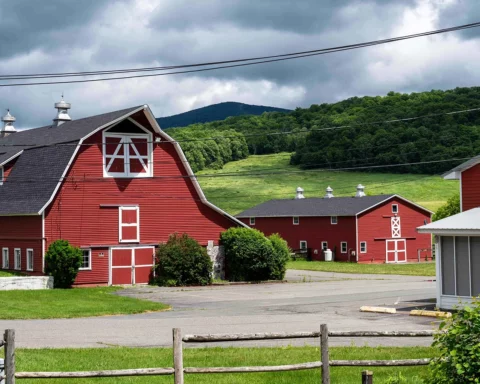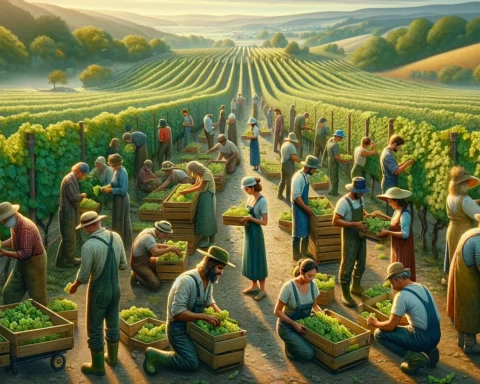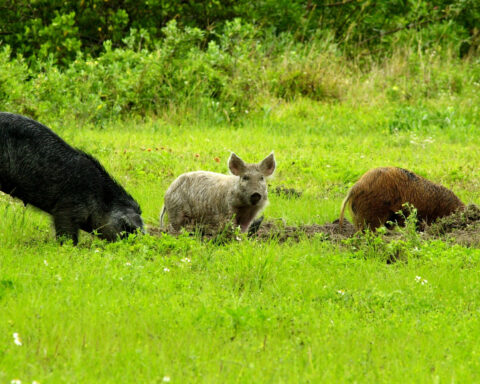Wisdom for the Word Weary
Scotch whisky is made from barley and the morning dew on angel’s nipples.
Warren Ellis
Parts I and II of this series offered suggestions on how to dine like royalty. In Part III, it’s time to return to earth and explore some culinary roots that feature one of the world’s most humble foods. Humble that is, except when touched by the divine. I’m talking about barley, a cereal grain that’s been a friend to mankind for at least 11,000 years.
Today, about seventy percent of the 330 billion pounds of barley raised around the world goes into animal feed. The rest goes into brewing beer and distilling Scotch whiskey, with a tiny fraction finding its way into into soups, stews, and as a staple in pockets of popularity in such places as Tibet.
Argument among scholars exists as to its origin, but Mongolia and Western China seem to be likely candidates for earliest domestication. From there, it spread quickly to to India, Persia, Mesopotamia, Syria and Egypt. Eventually, barely was being cultivated from Korea to Finland to the United States.
References to barley go way back. All the way to cuneiform clay cylinders. The Sumerian god second in command to Inanna was Ninurta, whose name means “Lord of Barley.” He was originally a god of agriculture and healing, though as Mesopotamia became more powerful and warlike, Ninurta traded in his barley stalks for spears. Then, centuries later, through a series of confusing errors committed by scribes (What do you want? They’re working with clay and papyrus!) The god Ninurta becomes Nimrod, first king to arise after the Great Flood, and who is credited with the construction of the Tower of Babel, depending on who you listen to.
But barley hardly exits the story of the early Jewish people here. Barley is one of the First Fruits, providing nourishment in the Spring after long, lean Winters. In fact, the word for Spring in Hebrew, “Aviv” (אביב), means “barley ripening”, which, in that biome, is going on throughout March. Passover week culminates with the Feast of First Fruits when, historically sheaves of barley were waved in the temple. Pentecost occurs 50 days after First Fruits in which the Jews celebrated the wheat harvest.
In both Europe, barley’s status began to ascend, as well. Worshippers of Demeter and Persephone, in ancient Greece, concocted barley into a mildly alcoholic beverage as part of their cultic rites. News of a good thing travels fast, and the science of fermentation became an officially sanctioned art in temples throughout the known world (Yeah, I mean, God says we have to drink this until we see visions, so…)
And, of course, Yahweh, having fielded enough criticism about his free shipments of manna way back in Exodus, decides to just bring the Jews to a place where they can harvest their own food and prepare it however they like. In the fifth book of the Torah, Devarim (Deuteronomy), God tells the Israelites that he’s gonna take care of them and deliver them from their tormentors in Egypt (where they can get BARLEY!)
For the LORD your God is bringing you into a good land—a land with brooks, streams, and deep springs gushing out into the valleys and hills; a land with wheat and barley, vines and fig trees, pomegranates, olive oil and honey.
God
Of course, half a chapter later come the threats and guilt trips and dickheadery:
17 You may say to yourself, “My power and the strength of my hands have produced this wealth for me.”
Also God
18 But remember the LORD your God, for it is he who gives you the ability to produce wealth, and so confirms his covenant, which he swore to your ancestors, as it is today.
19 If you ever forget the LORD your God and follow other gods and worship and bow down to them, I testify against you today that you will surely be destroyed.
20 Like the nations the LORD destroyed before you, so you will be destroyed for not obeying the LORD your God.
Which sounds REMARKABLY like the male part in Human League’s “Don’t You Want Me” from 1981
You were working as a waitress in a cocktail bar
Human League
When I met you
I picked you out, I shook you up
And turned you around
Turned you into someone new
Now five years later on you’ve got the world at your feet
Success has been so easy for you
But don’t forget it’s me who put you where you are now
And I can put you back down too
But I digress…
Over in India, barley is the main cereal grain consumed and the only one even mentioned in the ancient text for hundreds of years. Way over in Scandinavia, the Norse sub-god Byggvir, whose name translates to (you guessed it) barley, kept busy serving his master Frey and teaching the vikings how to make ale.
But the most powerful connection between barley and the poor comes from one of the most famous of Christ’s miracles — dividing the loaves and the fishes. Now, it should be mentioned that this one is the only miracle mentioned in all of the Gospels, so you know it was a real crowd-pleaser. And whether there were five loaves and two fish or seven loaves and a kettle of few fish doesn’t matter. What matters is that Jesus, noticing the crowd that had been following him around for several days probably hadn’t eaten, took that meager ingredients list and allegedly multiplied it to feed five thousand people . And that the bread was made of barley!
Jesus pulls off this mega-Stone Soup show as Passover approaches, (remember Passover wraps up with the Feast of First Fruits and Jews are sacrificing barley in thanks. Jesus will later blow people’s mind by saying that he himself is the bread of life, and that people should eat him (via the barley bread). Notably, barley was the first grain the Jews could harvest, so, high or low, rich or poor, all were equalized through dietary leveling.
In Europe, barley may have fed the masses, but not without engendering a certain amount of bitterness, as the peasants were forced to grow wheat for the landlords, but were only allowed to eat barley. The loaves of barley bread were often fortified with beans, seeds, and nuts, and came to be known as “cake.” Now does the “We want bread, not cake” complaint begin to make sense? Additionally, barley bread was used during one type of the typically fucked up trials by ordeal during the Middle Ages known as the accursed or sacred morsel,:
a suspected person eating a piece of barley bread and cheese totalling about an ounce in weight and consecrated with a form of exorcism as a trial of his innocence. If guilty, it was supposed the bread would produce convulsions and paleness and cause choking. If innocent, it was believed the person could swallow it freely, and the bread would turn to nourishment…
Wikipedia
Kind of takes the warm fuzzies out of humankind’s favorite grain, right?
The connections between barley and pagan practices in Europe and elsewhere are too numerous to list BUT, it must be pointed out that while barley was harvested in the Middle East in early April, above, say, the 45th parallel, barley is ripe a full season later at the beginning of August, which is why that month’s full moon is known as the “Barley Moon” (This year, in 2023, August 1st will bring the Barley Moon and the 31st will present a Blue Moon, which will also be a super moon!) That moon is also known as the Corn Moon, Berry Moon, Sturgeon Moon, or Red Moon.
And full moons have always been popular nights to get naked and rut around like pagans, celebrating one fertility festival or another, especially if you are…you know…a pagan. This year, the Barley Moon falls squarely on Lughnasadh, the Gaelic festival that kicks off harvest season in Ireland, Scotland and the Isle of Man. Christians, never known for originality when it comes to scheduling their own holidays, commandeered the celebration and renamed it Lammas, which comes from Loaf Mass — again, bread made from the First Fruit—barley.
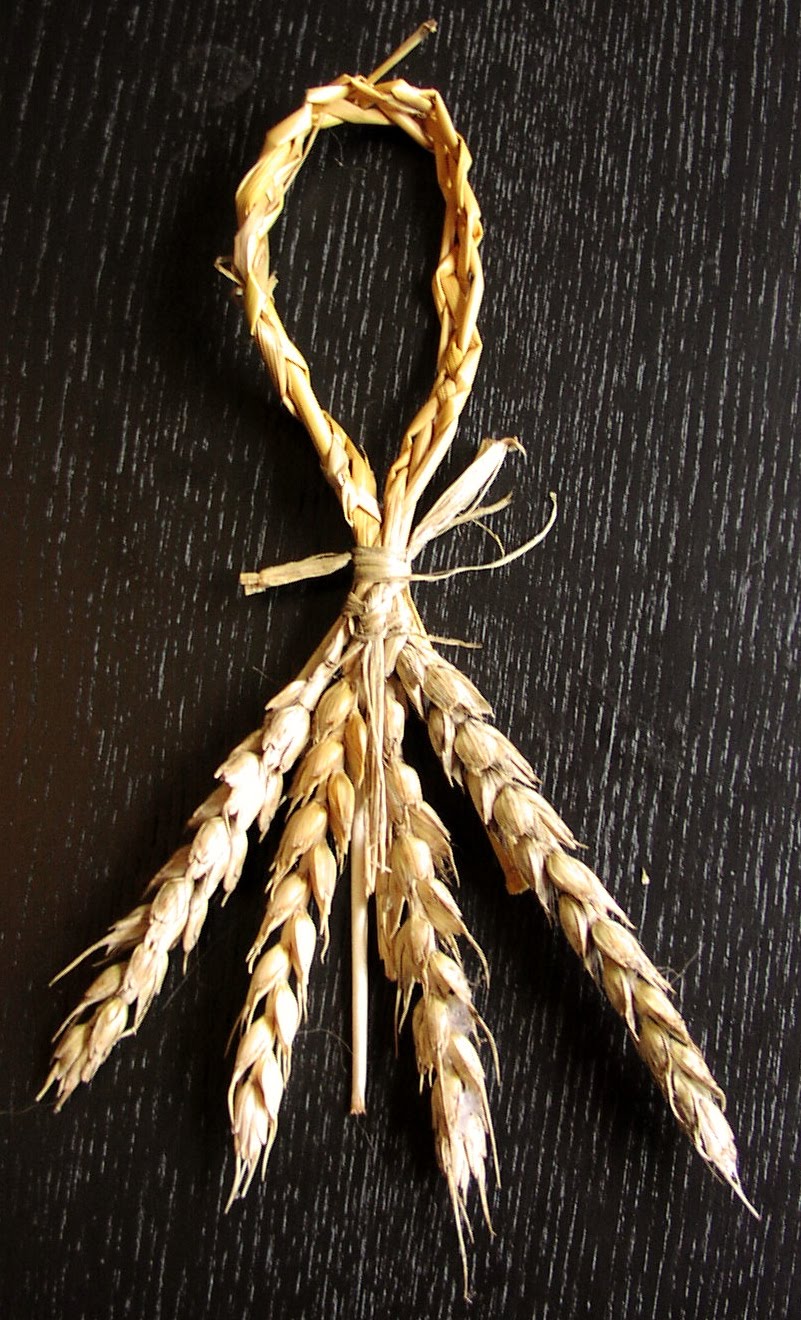
Starza, courtesy www.badwitch.co.uk
Both Christians and pagans, however, share a crafty tradition of weaving a few (or a multitude of) barley stalks into “Corn Dollies,” so called because in ancient times, the word corn was a catch-all term for all grains and cereal crops.
Farmers, pagan and Christian (with certain stubborn pagan holdover traditions) will make simple, or incredibly complex, corn dollies from stalks of the last swipe of of the scythe worth of barley (and/or wheat). The ritual catches the spirit of the crop, and by weaving it into a decoration and hanging it in the home can preserve the fertility for next year when it will be planted along with the rest of the seed.
And at harvest parties, men would wear this simple dolly shown on their lapel, and give it to the girl he’s sweet on, who will wear it during courtship.This is largely a Christian thing, but still…smacks of heathenism, doesn’t it?!
Make your own Corn Dolly, The “Gentleman’s Favour“
And finally, a song whose origins stretch back into the mists of antiquity, “John Barleycorn Must Die,” at first sounds like a brutal murder ballad, until you realize that it’s actually about the harvesting of barley and preparation into malt, later to be consumed as beer by everyone, from the high to the poorest of the poor in society! Traffic did a great version of the tune (below), as does Jethro Tull.
So, as a symbol of the poor, a symbol of fertility and rebirth, or a symbol of love, barley has occupied a place in the human story since before we even understood what class divisions would come to mean. GROW SOME! If only ceremoniously. A well fertilized patch about six feet square will provide you with a couple of meals and is just so beautiful to grow. Again, I’ll send you to order your seed from FEDCO, where you can pick up hull-less or “naked” barley that you won’t need a threshing room floor to break out of a husk.
John Barleycorn Must Die
Lyrics to the Robert Burns version of the song, 1782:
There was three kings into the east,
three kings both great and high,
and they hae sworn a solemn oath
John Barleycorn must die.
They took a plough and plough’d him down,
put clods upon his head,
and they hae sworn a solemn oath
John Barleycorn was dead.
But the cheerful Spring came kindly on’
and show’rs began to fall.
John Barleycorn got up again,
and sore surprised them all.
The sultry suns of Summer came,
and he grew thick and strong;
his head well arm’d wi’ pointed spears,
that no one should him wrong.
The sober Autumn enter’d mild,
when he grew wan and pale;
his bendin’ joints and drooping head
show’d he began to fail.
His colour sicken’d more and more,
and he faded into age;
and then his enemies began
to show their deadly rage.
They took a weapon, long and sharp,
and cut him by the knee;
they ty’d him fast upon a cart,
like a rogue for forgerie.
They laid him down upon his back,
and cudgell’d him full sore.
they hung him up before the storm,
and turn’d him o’er and o’er.
They filled up a darksome pit
with water to the brim,
they heav’d in John Barleycorn.
There, let him sink or swim!
They laid him upon the floor,
to work him farther woe;
and still, as signs of life appear’d,
they toss’d him to and fro.
They wasted o’er a scorching flame
the marrow of his bones;
but a miller us’d him worst of all,
for he crush’d him between two stones.
And they hae taen his very hero blood
and drank it round and round;
and still the more and more they drank,
their joy did more abound.
John Barleycorn was a hero bold,
of noble enterprise;
for if you do but taste his blood,
’twill make your courage rise.
‘Twill make a man forget his woe;
’twill heighten all his joy;
’twill make the widow’s heart to sing,
tho the tear were in her eye.
Then let us toast John Barleycorn,
each man a glass in hand;
and may his great posterity
ne’er fail in old Scotland!


